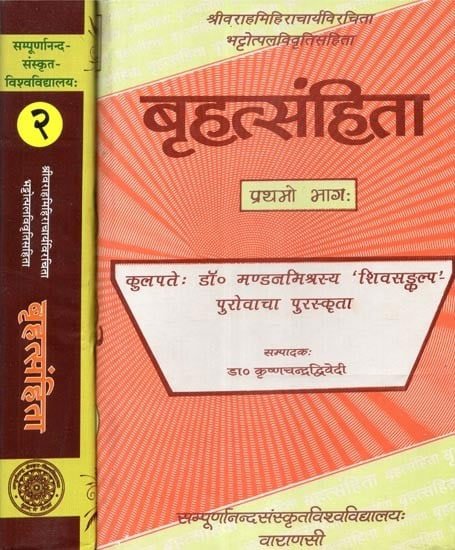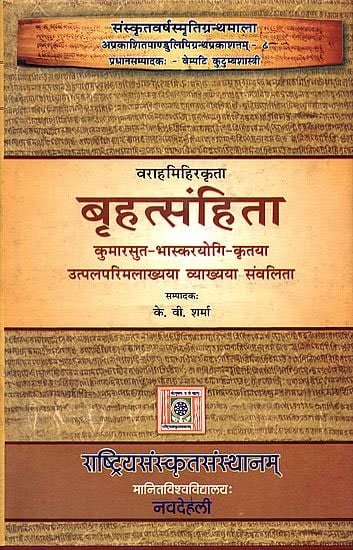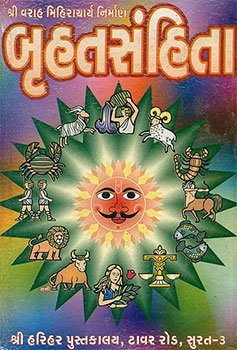Brihat-samhita [sanskrit]
26,560 words
The Sanskrit text of the Brihat-samhita from the 6th-century authored by Varaha Mihira in present-day Ujjain, India. It primarily deals with astrology and astronomy but is presented as an encyclopedia of knowledge.
Verse 20.1
यस्यां दिशि दृश्यन्ते विशन्ति ताराग्रहा रविं सर्वे ।
भवति भयं दिशि तस्यामायुधकोपक्षुधातङ्कैः ॥ १ ॥
yasyāṃ diśi dṛśyante viśanti tārāgrahā raviṃ sarve |
bhavati bhayaṃ diśi tasyāmāyudhakopakṣudhātaṅkaiḥ || 1 ||
The Sanskrit text of Verse 20.1 is contained in the book Brihata Samhita (Sanskrit Text with Hindi Translation) by Pandit Achyutananda Jha. This book is available online or you could buy the latest edition:
Read online Buy now! The Sanskrit text by Pandit Achyutananda Jha (2001)
Glossary of Sanskrit terms
Note: This extracts Sanskrit terms and links to English definitions from the glossary, based on an experimental segmentation of verse (20.1). Some terms could be superfluous while some might not be mentioned. Click on the word to show English definitions.
Yasya, Dish, Vishat, Vishanti, Taragraha, Ravi, Sarva, Bhavati, Bhavat, Bhavant, Bhaya, Ayudha, Kopa, Kshudha, Anka,
Analysis of Sanskrit grammar
Note: this is an experimental feature and only shows the first possible analysis of the Sanskrit text (Verse 20.1). If the system was successful in segmenting the sentence, you will see of which words it is made up of, generally consisting of Nouns, Pronouns, Verbs, Participles and Indeclinables. Click on the link to show all possible derivations of the word.
- Line 1: “yasyāṃ diśi dṛśyante viśanti tārāgrahā raviṃ sarve ”
- yasyām -
-
yasyā (noun, feminine)[accusative single]yā (noun, feminine)[locative single]yā (pronoun, feminine)[locative single]
- diśi -
-
diś (noun, feminine)[locative single]
- dṛśyante -
-
√dṛś (verb class 1)[present passive third plural]
- viśanti -
-
viśantī (noun, masculine)[adverb]viśantī (noun, feminine)[compound], [adverb], [vocative single]viśantī (noun, neuter)[compound], [adverb], [nominative single], [vocative single], [accusative single]√viś -> viśat (participle, neuter)[nominative plural from √viś class 6 verb], [vocative plural from √viś class 6 verb], [accusative plural from √viś class 6 verb]√viś -> viśantī (participle, feminine)[vocative single from √viś class 6 verb]√viś (verb class 6)[present active third plural]
- tārāgrahā* -
-
tārāgraha (noun, masculine)[nominative plural], [vocative plural]
- ravim -
-
ravi (noun, masculine)[accusative single]
- sarve -
-
sarva (noun, masculine)[nominative plural], [locative single]sarva (noun, neuter)[nominative dual], [vocative dual], [accusative dual], [locative single]sarvā (noun, feminine)[nominative dual], [vocative single], [vocative dual], [accusative dual]
- Line 2: “bhavati bhayaṃ diśi tasyāmāyudhakopakṣudhātaṅkaiḥ ”
- bhavati -
-
bhavatī (noun, feminine)[adverb], [vocative single]bhavat (noun, masculine)[locative single]bhavat (noun, neuter)[locative single]bhavant (pronoun, masculine)[locative single]bhavant (pronoun, neuter)[locative single]√bhū (verb class 1)[present active third single]
- bhayam -
-
bhaya (noun, masculine)[adverb], [accusative single]bhaya (noun, neuter)[adverb], [nominative single], [accusative single]bhayā (noun, feminine)[adverb]
- diśi -
-
diś (noun, feminine)[locative single]
- tasyāmā -
-
√tas (verb class 4)[imperative active first plural]
- ayudha -
-
ayudha (noun, masculine)[compound], [vocative single]
- kopa -
-
kopa (noun, masculine)[compound], [vocative single]
- kṣudhāt -
-
kṣudha (noun, masculine)[adverb], [ablative single]kṣudha (noun, neuter)[adverb], [ablative single]
- aṅkaiḥ -
-
aṅka (noun, masculine)[instrumental plural]aṅka (noun, neuter)[instrumental plural]
Other editions:
Also see the following editions of the Sanskrit text or (alternative) English translations of the Verse 20.1
Brhatsamhita with the Commentary of Bhattotpala
by Krishna Chandra Dwivedi (2016)
Publisher: Sampurnanand Sanskrit University; 1229 pages;
Buy now!
Brihat Samhita with the Commentary of Utpalapatimala of Yogisvara
by K. V. Sharma (2012)
Publisher: Rashtriya Sanskrit Sansthan, Janakpuri; 754 pages; ISBN-10; 8186111360; ISBN-13: 9788186111369
Buy now!
Brihat Samhita (Hindi Translation)
by K. V. Sharma (2002)
Publisher: Sampurnanand Sanskrit University; 2359 pages; ISBN-13: 9789387890008.
Buy now!
Brhat Samhita (English translation)
by N. Chidambaram Iyer (2022)
Publisher: Parimal Publication Pvt. Ltd.; 801 pages; Edited by Dr. Shrikrishna Jugnu; ISBN-10: 8171104215; ISBN-13: 9788171104215.
Buy now!
Brhat Samhita (English with notes)
by M. Ramakrishna Bhat (2010)
Publisher: Motilal Banarsidas Publishers Pvt. Ltd.; 1155 pages; ISBN-10: 8120810600; ISBN-13: 9788120810600.
Buy now!
Brhat Samhita (Telugu translation)
by Sishtla Umamaheswara Sharma (2020)
Publisher: Mohan Publications, Andhra Pradesh; 846 pages.
Buy now!Preview of verse 20.1 in Kannada sript:
ಯಸ್ಯಾಂ ದಿಶಿ ದೃಶ್ಯನ್ತೇ ವಿಶನ್ತಿ ತಾರಾಗ್ರಹಾ ರವಿಂ ಸರ್ವೇ ।
ಭವತಿ ಭಯಂ ದಿಶಿ ತಸ್ಯಾಮಾಯುಧಕೋಪಕ್ಷುಧಾತಙ್ಕೈಃ ॥ ೧ ॥
Brhat Samhita (Gujarati translation)
by - (2000)
Publisher: Shree Harihar Pustakalay, Surat; Author: Shri Varahamihira Acharya (શ્રી વરાહમિહીરાચાર્ય); 432 pages.
Buy now!Preview of verse 20.1 in Gujarati sript:
યસ્યાં દિશિ દૃશ્યન્તે વિશન્તિ તારાગ્રહા રવિં સર્વે ।
ભવતિ ભયં દિશિ તસ્યામાયુધકોપક્ષુધાતઙ્કૈઃ ॥ ૧ ॥
Brhat Samhita (Kannada translation)
by Sripada Raghunatha Kulkarni (2021)
Publisher: Srinidhi Publications, Bangalore; 668 pages with illustrations.
Buy now!Preview of verse 20.1 in Kannada sript:
ಯಸ್ಯಾಂ ದಿಶಿ ದೃಶ್ಯನ್ತೇ ವಿಶನ್ತಿ ತಾರಾಗ್ರಹಾ ರವಿಂ ಸರ್ವೇ ।
ಭವತಿ ಭಯಂ ದಿಶಿ ತಸ್ಯಾಮಾಯುಧಕೋಪಕ್ಷುಧಾತಙ್ಕೈಃ ॥ ೧ ॥
![Brihat-samhita [sanskrit] - book cover](/uploads/a/Brihat-Samhita-Sanskrit.jpg)







